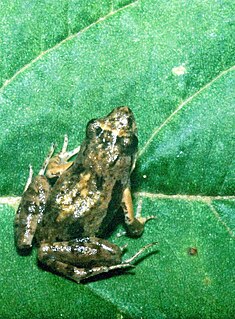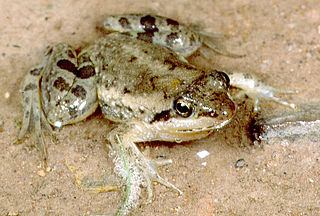Phrynobatrachus latifrons, the Ahl's river frog or savanna puddle frog, is a species of frog in the family Phrynobatrachidae. It is found from Senegal in West Africa east to northern Cameroon and eastern Chad in western Central Africa. The IUCN Red List includes the following West African countries : Benin, Burkina Faso, Ivory Coast, Gambia, Ghana, Guinea, Liberia, Mali, Nigeria, Senegal, Sierra Leone, and Togo.

Phrynobatrachus calcaratus, the Boutry river frog or Peters' puddle frog, is a species of frog in the family Phrynobatrachidae. It is widely distributed in West Africa and Middle Africa. However, this nominal species is a species complex consisting of several species.
Phrynobatrachus dalcqi is a species of frogs in the family Phrynobatrachidae. It is endemic to the eastern Democratic Republic of the Congo and only known from Fizi Territory in the South Kivu province. The specific name dalcqi honours "Professor A. Dalcq", presumably Albert Dalcq (1893–1973), a Belgian embryologist. Common names Kivu river frog and Dalcq's puddle frog have been proposed for it.
Phrynobatrachus graueri is a species of frog in the family Phrynobatrachidae. It is found in eastern Democratic Republic of the Congo, Rwanda, Uganda, and western Kenya. The specific name graueri honours Rudolf Grauer, Austrian explorer and zoologist who collected the holotype. Common names Rugege river frog and Grauer's puddle frog have been coined for it.
Phrynobatrachus gutturosus, the Chabanaud's river frog or guttural puddle frog, is a species of frog in the family Petropedetidae. It is found in Democratic Republic of the Congo, Ivory Coast, Ghana, Liberia, Nigeria, possibly Benin, possibly Burkina Faso, possibly Guinea, possibly Mali, possibly Togo, and possibly Uganda. Its natural habitats are subtropical or tropical moist lowland forest, moist savanna, swampland, and intermittent freshwater marshes. It is threatened by habitat loss.
Phrynobatrachus inexpectatus is a species of frog in the family Phrynobatrachidae. It is endemic to southern Ethiopia. It is known with confidence from only three localities, but it may be more widely distributed in the Ethiopian Highlands. The specific name inexpectatus refers to the unexpected discovery of this species among museum specimens assigned to Phrynobatrachus minutus. Common names unexpected puddle frog and Largen's dwarf puddle frog have been coined for it.
Phrynobatrachus irangi is a species of frog in the family Phrynobatrachidae. It is endemic to Kenya and is known only from two localities, its type locality, the eponymous Irangi Forest on the south-eastern slopes of Mount Kenya, and Kimande on the south-eastern slopes of the Aberdare Range. Common name Irangi puddle frog has been coined for it.
Phrynobatrachus kinangopensis is a species of frog in the family Phrynobatrachidae. It is endemic to the Kenyan Highlands east of the Great Rift Valley. Both the scientific name and its common names, Kinangop river frog and Kinangop puddle frog, refer to its type locality, Mount Kinangop.

Phrynobatrachus minutus is a species of frog in the family Phrynobatrachidae. It is endemic to Ethiopia and occurs in the central and southern parts of the country on both sides of the Rift Valley; its range may extend south to Kenya, perhaps further. Some earlier records from Ethiopia represent Phrynobatrachus inexpectatus, described as a new species in 2001. The specific name minutus refers to the small size of this frog. Common names tiny river frog and Ethiopian dwarf puddle frog have been coined for it.

The Natal dwarf puddle frog is a species of frog in the family Phrynobatrachidae. It is found in Angola, Benin, Botswana, Burundi, Cameroon, Central African Republic, Republic of the Congo, Democratic Republic of the Congo, Ivory Coast, Eritrea, Ethiopia, Gambia, Ghana, Guinea, Guinea-Bissau, Kenya, Liberia, Malawi, Mali, Mozambique, Namibia, Nigeria, Rwanda, Senegal, Sierra Leone, South Africa, Sudan, Swaziland, Tanzania, Togo, Uganda, Zambia, Zimbabwe, and possibly Burkina Faso, Chad, Lesotho, and Mauritania.
Phrynobatrachus pakenhami is a frog species in the family Phrynobatrachidae. It is endemic to Pemba Island off Tanzania. It is similar to Phrynobatrachus acridoides, its sister species, but the two species differ in ecology and male advertisement call. On the other hand, the recently described, supposed diminutive species P. nigripes was simply based on juveniles and subadults of P. pakenhami.
Phrynobatrachus parkeri is a species of frog in the family Phrynobatrachidae. It is endemic to the west-central and northeastern Democratic Republic of the Congo. It is only known from a few widely separated localities. It is similar to Phrynobatrachus acridoides(Cope, 1867), and it might be a synonym of the latter. The specific name parkeri honors Hampton Wildman Parker, an English zoologist and herpetologist. Common name Parker's river frog has been coined for it.

Phrynobatrachus parvulus is a species of frog in the family Phrynobatrachidae. It is widely distributed in the upland areas of Central and East Africa in Angola, northern Botswana, northern Zimbabwe, Zambia, southeastern Democratic Republic of the Congo, Malawi, and Tanzania. However, many identifications are problematic, and the taxonomic status of this species with respect to Phrynobatrachus mababiensis and P. ukingensis requires clarification; in the more inclusive species delimitation applied by the IUCN SSC Amphibian Specialist Group, also Uganda is tentatively included in the range of this species. Common names Loanda river frog, dwarf puddle frog, and little puddle frog have been proposed for this species.

Phrynobatrachus perpalmatus is a species of frog in the family Phrynobatrachidae. It is found in the area stretching from the central and southern Sudan southward through South Sudan and central/eastern Democratic Republic of the Congo, extreme western Tanzania, Burundi, Malawi, and Zambia to northern Mozambique; its range might extend into northern Zimbabwe. Common names Lake Mwero river frog and webbed puddle frog have been proposed for it.
Phrynobatrachus rungwensis is a species of frog in the family Phrynobatrachidae. It is found in southeastern Democratic Republic of the Congo, central and northern Malawi, and east to southern and central Tanzania. It is also expected to occur in northeastern Zambia. Common names Rungwe puddle frog and Rungwe river frog have been coined for it. It is named after Mount Rungwe, its type locality.
Phrynobatrachus stewartae, also known as the Stewart's puddle frog or Stewart's river frog, is a species of frog in the family Phrynobatrachidae. It is found in northern Malawi and south-central and western Tanzania. The specific name stewartae honours Margaret M. Stewart, an American herpetologist who wrote "Amphibians of Malawi" (1967) and collected the type series, originally identified as Phrynobatrachus gutturosus.
Phrynobatrachus ukingensis is a species of frog in the family Phrynobatrachidae. It is recorded in several places in southern and eastern Tanzania and in northern and southern Malawi ; it probably occurs more widely, at least in areas in between the known localities. Common names Ukinga puddle frog and Ukinga river frog have been coined for it.
Phrynobatrachus uzungwensis is a species of frogs in the family Phrynobatrachidae. It is endemic to eastern Tanzania and is known from the Udzungwa, Uluguru, Nguu, and Nguru Mountains. Common names Ukinga puddle frog and Udzungwa puddle frog have been coined for this species.
Phrynobatrachus versicolor is a species of frog in the family Phrynobatrachidae. It is found in northwestern Burundi, western Rwanda, southwestern Uganda, and adjacent eastern Democratic Republic of the Congo. Common names Rwanda river frog and green puddle frog have been coined for it. The specific name versicolor, derived from the Latin versare and color, and refers to its variable dorsal colouration.
Phrynobatrachus werneri is a species of frog in the family Phrynobatrachidae. It is only known with certainty from western Cameroon, although there is a putative record from Chappal Waddi in Nigeria, close to the border of Cameroon; the earlier record from the Obudu Plateau in Nigeria is now assigned to Phrynobatrachus schioetzi described as a new species in 2011. The status of Phrynobatrachus manengoubensis from Mount Manengouba remains unclear, with some questioning its distinctness from Phrynobatrachus werneri. Common name Werner's river frog has been coined for this species.






